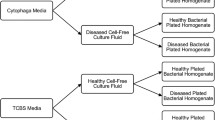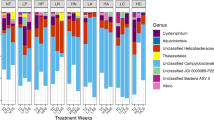Abstract
Incidents of coral disease are on the rise. However, in the absence of a surrogate animal host, understanding of the interactions between coral pathogens and their hosts remains relatively limited, compared to other pathosystems of similar global importance. A tropical sea anemone, Aiptasia pallida, has been investigated as a surrogate model to study certain aspects of coral biology. Therefore, to test whether the utility of this surrogate model can be extended to study coral diseases, in the present study, we tested its susceptibility to common coral pathogens (Vibrio coralliilyticus and Vibrio shiloi) as well as polymicrobial consortia recovered from the Caribbean Yellow Band Disease (CYBD) lesions. A. pallida was susceptible to each of the tested pathogens. A. pallida responded to the pathogens with darkening of the tissues (associated with an increased melanization) and retraction of tentacles, followed by complete disintegration of polyp tissues. Loss of zooxanthellae was not observed; however, the disease progression pattern is consistent with the behavior of necrotizing pathogens. Virulence of some coral pathogens in Aiptasia was paralleled with their glycosidase activities.




Similar content being viewed by others
References
Bourne DG, Garren M, Work TM, Rosenberg E, Smith GW, Harvell CD (2009) Microbial disease and the coral holobiont. Trends Microbiol 17:554–562. doi:10.1016/j.tim.2009.09.004
Rosenberg E, Koren O, Reshef L, Efrony R, Zilber-Rosenberg I (2007) The role of microorganisms in coral health, disease and evolution. Nature Rev Microbiol 5:355–362. doi:10.1038/nrmicro1635
Rosenberg E, Kushmaro A, Kramarsky-Winter E, Banin E, Yossi L (2009) The role of microorganisms in coral bleaching. ISME J 3:139–146. doi:10.1038/ismej.2008.104
Kushmaro A, Rosenberg E, Fine M, Loya Y (1997) Bleaching of the coral Oculina patagonica by Vibrio AK-1. Mar Ecol-Prog Ser 147:159–165. doi:10.3354/meps147159
Kushmaro A, Banin E, Loya Y, Stackebrandt E, Rosenberg E (2001) Vibrio shiloi sp. nov., the causative agent of bleaching of the coral Oculina patagonica. Int’l J Sys Evol Microbiol 51:1383–1388
Arotsker L, Siboni N, Ben-Dov E, Kramarsky-Winter E, Loya Y, Kushmaro A (2009) Vibrio sp. as a potentially important member of the Black Band Disease (BBD) consortium in Favia sp. corals. FEMS Microbiol Ecol 70:515–524. doi:10.1111/j.1574-6941.2009.00770.x
Ritchie KB (2006) Regulation of microbial populations by coral surface mucus and mucus-associated bacteria. Mar Ecol Prog Ser 322:1–14
Sussman M, Loya Y, Fine M, Rosenberg E (2003) The marine fireworm Hermodice carunculata is a winter reservoir and spring–summer vector for the coral-bleaching pathogen Vibrio shiloi. Environ Microbiol 5:250–255
Ben-Haim Y, Thompson FL, Thompson CC, Cnockaert MC, Hoste B, Swings J, Rosenberg E (2003) Vibrio coralliilyticus sp. nov., a temperature-dependent pathogen of the coral Pocillopora damicornis. Int’l J System Evol Micrbiol 53:309–315. doi:10.1099/ijs.0·02402-0
Sussman M, Willis BL, Victor S, Bourne DG (2008) Coral pathogens identified for white syndrome (WS) episootics in the Indo-Pacific. PLoS One 3:e2393. doi:10.1371/journal.pone.0002393
Kimes NE, Grim CJ, Johnson WR, Hasan NA, Tall BD, Kothary MH, Kiss H, Munk AC, Tapia R, Green L, Detter C, Bruce DC, Brettin TS, Colwell RR, Morris PJ (2011) Temperature regulation of virulence factors in the pathogen Vibrio coralliilyticus. ISME J 6:835–846. doi:10.1038/ismej.2011.154
Ben-Haim Y, Zicherman-Keren M, Rosenberg E (2003) Temperature-regulated bleaching and lysis of the coral Pocillopora damicornis by the novel pathogen Vibrio coralliilyticus. Appl Environ Microbiol 69:4236–4242
Weil E, Ritchie KB, Croquer A, Cunning JR, Smith GW (2008) Inoculation of Vibrio spp. onto Montastraea faveolata fragments to determine potential pathogenicity. Proceedings of the 11th International Coral Reef Symposium, Ft Lauderdale, Florida 1:202–205
Cervino JM, Thompson FL, Gomez-Gil B, Lorence EA, Goreau TJ, Hayes RL, Winiarski-Cervino KB, Smith GW, Hughen K, Bartels E (2008) The Vibrio core group induces yellow band disease in Caribbean and Indo-Pacific reef-building corals. J Appl Microbiol 105:1658–1671. doi:10.1111/j.1365-2672.2008.03871.x
Cunning JR, Thurmond JE, Smith GW, Weil E, Ritchie KB (2008) A survey of vibrios associated with healthy and Yellow Band diseased Montastraea faveolata. In: Proceedings of the 11th International Coral Reef Symposium, Ft Lauderdale, Florida, 7–11 July 2008, 1, pp 206–210
Ban SS, Graham NA, Connolly SR (2013) Evidence for multiple stressor interactions and effects on coral reefs. Glob Chang Biol. doi:10.1111/gcb.12453
Burge CA, Kim CJ, Lyles JM, Harvell CD (2013) Special issue Oceans and Humans Health: the ecology of marine opportunists. Microb Ecol 65:869–879. doi:10.1007/s00248-013-0190-7
Weis VM, Davy SK, Hoegh-Guldberg O, Rodriguez-Lanetty M, Pringle JR (2008) Cell biology in model systems as the key to understanding corals. Trends Ecol Evol 23:369–376. doi:10.1016/j.tree.2008.03.004
Sunagawa S, Wilson EC, Thaler M, Smith ML, Caruso C, Pringle JR, Weis VM, Medina M, Schwarz JA (2009) Generation and analysis of transcriptomic resources for a model system on the rise: the sea anemone Aiptasia pallida and its dinoflagellate endosymbiont. BMC Genomics 10:258. doi:10.1186/1471-2164-10-258
Lehnert EM, Burriesci MS, Pringle JR (2012) Developing the anemone Aiptasia as a tractable model for cnidarian–dinoflagellate symbiosis: the transcriptome of aposymbiotic A. pallida. BMC Genomics 13:271
Weis VM (2008) Cellular mechanisms of Cnidarian bleaching: stress causes the collapse of symbiosis. J Exp Biol 211:3059–3066. doi:10.1242/jeb.009597
Davy SK, Allemand D, Weis VM (2012) Cell biology of cnidarian–dinoflagellate symbiosis. Microbiol Mol Biol Rev 76:229–261. doi:10.1128/MMBR.05014-11
Krediet CJ, Ritchie KB, Cohen M, Lipp EK, Sutherland KP, Teplitski M (2009) Utilization of mucus from the coral Acropora palmata by the pathogen Serratia marcescens and by environmental and coral commensal bacteria. Appl Environ Microb 75:3851–3858. doi:10.1128/Aem.00457-09
Krediet CJ, Carpinone EM, Ritchie KB, Teplitski M (2012) Characterization of the gacA-dependent surface and coral mucus colonization by an opportunistic coral pathogen Serratia marcescens PDL100. FEMS Microbiol Ecol. doi:10.1111/1574-6941.12064
Alagely A, Krediet CJ, Ritchie KB, Teplitski M (2011) Signaling-mediated cross-talk modulates swarming and biofilm formation in a coral pathogen Serratia marcescens. ISME J 5:1609–1620. doi:10.1038/ismej.2011.45
Kaplan EL, Meier P (1958) Nonparametric estimation from incomplete observations. J Amer Statist Assn 53(282):457–481
Hosmer DW, Lemeshow S (1999) Applied survival analysis. Wiley, New York
Xiang TT, Hambleton EA, DeNofrio JC, Pringle JR, Grossman AR (2013) Isolation of clonal axenic strains of the symbiotic dinoflagellate Symbiodinium and their growth and host specificity. J Phycol 49:447–458. doi:10.1111/Jpy.12055
Tolleter D, Seneca FO, DeNofrio JC, Krediet CJ, Palumbi SR, Pringle JR, Grossman AR (2013) Coral bleaching independent of photosynthetic activity. Curr Biol 23:1782–1786. doi:10.1016/J.Cub.2013.07.041
Krediet CJ, Ritchie KB, Teplitski M (2009) Catabolite regulation of enzymatic activities in a white pox pathogen and commensal bacteria during growth on mucus polymers from the coral Acropora palmata. Dis Aquat Organ 87:57–66. doi:10.3354/Dao02084
Yu Z, Morrison M (2004) Comparisons of different hypervariable regions of rrs genes for use in fingerprinting of microbial communities by PCR-denaturing gradient gel electrophoresis. Appl Environ Microbiol 70:4800–4806. doi:10.1128/AEM.70.8.4800-4806.2004
Mshvildadze M, Neu J, Shuster J, Theriaque D, Li N, Mai V (2010) Intestinal microbial ecology in premature infants assessed with non-culture-based techniques. J Pediatrics 156:20–25. doi:10.1016/j.jpeds.2009.06.063
Mydlarz LD, Holthouse SF, Peters EC, Harvell CD (2008) Cellular responses in sea fan corals: granular amoebocytes react to pathogen and climate stressors. PLoS One 3:e1811. doi:10.1371/journal.pone.0001811
Austin B, Austin D, Sutherland R, Thompson F, Swings J (2005) Pathogenicity of vibrios to rainbow trout (Oncorhynchus mykiss, Walbaum) and Artemia nauplii. Environ Microbiol 7:1488–1495. doi:10.1111/j.1462-2920.2005.00847.x
Mydlarz LD, Harvell CD (2007) Peroxidase activity and inducibility in the sea fan coral exposed to a fungal pathogen. Comp Biochem Physiol A Mol Integr Physiol 146:54–62. doi:10.1016/j.cbpa.2006.09.005
Palmer CV, Bythell JC, Willis BL (2011) A comparative study of phenoloxidase activity in diseased and bleached colonies of the coral Acropora millepora. Dev Compar Immunol 35:1096–1099. doi:10.1016/J.Dci.2011.04.001
Cervino JM, Hayes RL, Polson SW, Polson SC, Goreau TJ, Martinez RJ, Smith GW (2004) Relationship of Vibrio species infection and elevated temperatures to yellow blotch/band disease in Caribbean corals. Appl Environ Microbiol 70:6855–6864. doi:10.1128/AEM.70.11.6855-6864.2004
Acknowledgments
This work was supported by “Protect Our Reefs,” a program managed by Mote Marine Laboratory with the proceeds from the state-wide sales of Protect Our Reefs specialty license plates and administered through a peer-reviewed mechanism (to WJZ, CJK, MT, and KBR) and Dart Foundation funding (to KBR). We thank Erich Bartels for field support and Robert Camacho for assistance with infections. We are grateful to Volker Mai and Maria Ukhanova for guidance and support with the DGGE experiments. WJZ acknowledges support from the National Science Foundation Graduate Fellowship (grant no. DGE-0802270).
Author information
Authors and Affiliations
Corresponding author
Electronic Supplementary Material
Below is the link to the electronic supplementary material.
Supplemental Figure 1
Symbiodinium cell counts within Aiptasia exposed to bacteria. Individual Aiptasia strain CC7 anemones were infected with either an α-proteobacterium 45A11 recovered from Symbiodinium Clade D2 (A) or the coral pathogen V. coralliilyticus (B) at three concentrations (108, 107, 106 cfu ml−1). Anemones were sampled prior to the infection (day 0) and 1, 3, and 5 days after infection. Symbiodinium cell numbers were measured by Guava flow-cytometry and were normalized to anemone protein content as described in the “Methods.” Means (N = 8) ± SEM are plotted (PDF 86 kb)
Supplemental Figure 2
DGGE analysis of A. pallida-associated microbiota following challenge with the reconstituted CYBD. Polyps infected with the reconstituted CYBD (consisting of Vibrio-like strains 1B4, 3B7, 1H5, and 2H12, previously isolated from the CYBD-affected M. faveolata) and un-infected polyps were rinsed in sterile artificial seawater, and DNA was extracted using Qiagen QIAamp Stool Kit (Qiagen, Valencia, CA, USA) following the manufacturer’s instructions. The extracted DNA was subject to PCR to amplify V6–V8 region of the 16S rRNA gene [31, 32]. DNA from the mix of the bacterial strains (Vibrio spp. 1B4, 3B7, 1H5 and Photobacterium sp. 2H12) grown overnight was treated similarly and used as a control. DGGE was conducted as before [32]. Arrows point to the bands that are present in the reconstituted CYBD and are absent from the un-infected polyps. (PDF 298 kb)
Rights and permissions
About this article
Cite this article
Zaragoza, W.J., Krediet, C.J., Meyer, J.L. et al. Outcomes of Infections of Sea Anemone Aiptasia pallida with Vibrio spp. Pathogenic to Corals. Microb Ecol 68, 388–396 (2014). https://doi.org/10.1007/s00248-014-0397-2
Received:
Accepted:
Published:
Issue Date:
DOI: https://doi.org/10.1007/s00248-014-0397-2




